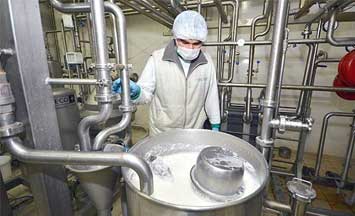Usage Areas of Heat Exchangers in Dairy Industry
Usage Areas of Heat Exchangers in Dairy Industry: Heat exchangers are widely used in various milk processing and product production processes. These exchangers play an important role in pasteurization, homogenization, cooling, condensation and other processes of milk. Here are the main areas of use of heat exchangers in the dairy industry:
Use of Heat Exchangers in the Dairy Industry

Usage Areas of Heat Exchangers in Dairy Industry
In the old days, when the dairy industry had become a complex business, it was a problem to offer milk, butter and cheese products in a limited area. But now, dairy producers supply a complex and ever-changing range of products to customers around the world. The rapid change in customer demands and trends requires you to be successful in the milk market.
This is about where and how SPX can help. With over a century of experience in the dairy industry, we know how to shorten delivery times and reduce costs, where quality is increasingly improving. We follow a very specific new product development program that helps ensure the right product at the right time. Usage Areas of Heat Exchangers in Dairy Industry
Usage Areas of Heat Exchangers in Dairy Industry
- Pasteurization: Pasteurization of milk is important to destroy harmful microorganisms in milk and extend the shelf life of the product. Heat exchangers are used to heat milk at a certain temperature for a certain period of time and then cool it rapidly. This process ensures that milk is presented to the consumer in a hygienic and safe manner.
- Hot Water Production: In milk processing plants, sufficient amounts of hot water are required for cleaning and sanitation. Heat exchangers ensure efficient recovery of the energy used to produce this hot water.
- Milk Condensation: In the dairy industry, concentrated milk is obtained by evaporating the water of milk during the milk condensation process. Heat exchangers ensure efficient recovery of the energy used in steam heating the milk and evaporating the water.
- Homogenization: In the milk processing process, homogenization ensures that the fat droplets of milk are distributed to a small and even size. Heat exchangers are used to heat milk and pass it under pressure during homogenization.
- Cooling: During milk pasteurization and other processes, milk must be rapidly cooled to a certain temperature. Heat exchangers play an important role in systems used to cool milk and improve product quality.
- Production of Dairy Products: Heat exchangers are used in the dairy industry for the production of many products such as cheese, yoghurt, cream and ice cream. Temperature control is critical in the production processes of these products and heat exchangers are used in these processes. Usage Areas of Heat Exchangers in Dairy Industry
The specific reasons why SPX is the world leader in the dairy industry are:
- SPX has inventions for oil standardization with APV Compomaster with quality components; APV palarisator for UHT infusion and APV Upperizer for UHT injection.
- It has expertise in hygienic engineering including CIP in accordance with the highest international standards.
- SPX maintains a worldwide sales and service network to provide comprehensive customer support.
- It has engineering-designed facilities that provide all kinds of services for operator training.
- We ensure the continuity of process centers where you can train operators or test equipment.
- We renew our inventions through continuous research and development.
- While SPX offers production components on a single line, it also offers a wide range of packaging solutions.
We have expertise in processing liquid milk, cheese and whey products, butter and yellow butter, dried, agglomerated, evaporated and condensed products, cultured products, baby foods and soy milk.Usage Areas of Heat Exchangers in Dairy Industry play a critical role in improving product quality, reducing energy costs and increasing production efficiency. For this reason, heat exchangers are widely used in milk processing plants.





